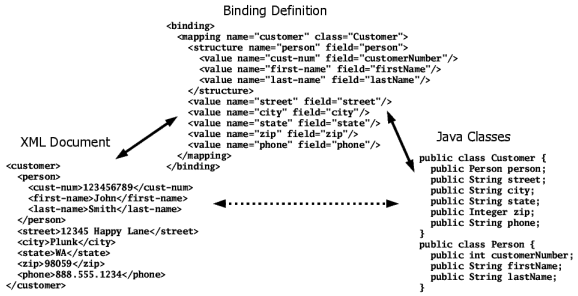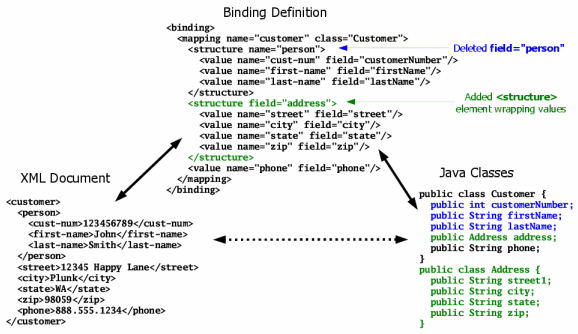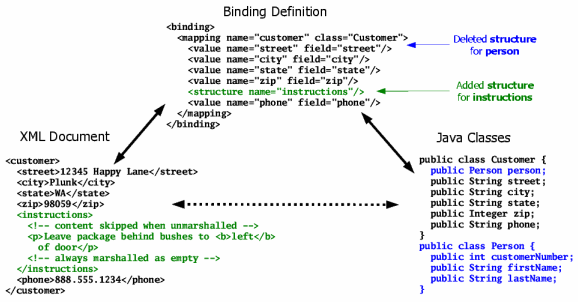Structure mapping between XML and Java |
Structure mappingJiBX's binding definition file provides great flexibility for converting between XML documents and Java object structures. Other data binding frameworks generally limit customization to just the names and the style (attribute or element) of XML representations. JiBX goes further by allowing structure mapping between XML and object structures. Figure 4 shows the same example as Figure 1. This basic type of binding, where the structure of the XML is the same as the structure of the Java objects, is typical of what's supported by most data binding frameworks. Figure 4. Simple binding example
What most frameworks will not allow you to do is to bring the values within the name element into the the object that corresponds to the customer element. In other words, you can't map the XML to this class: public class Customer {
public int customerNumber;
public String firstName;
public String lastName;
public String street;
public String city;
public String state;
public Integer zip;
public String phone;
}
Nor can you map the XML to a pair of classes like these: public class Customer {
public int customerNumber;
public String firstName;
public String lastName;
public Address address;
public String phone;
}
public class Address {
public String street1;
public String city;
public String state;
public String zip;
}
JiBX does allow you to do this type of mapping. This means the structure of your objects is not tied to the structure of the XML - you can restructure your object classes without needing to change the XML format used for external data transfer. Figure 5 shows a binding definition for the first case above, with the changes shown in blue. Figure 5. Flattened binding
The only difference in this binding definition from Figure
4 is that I've removed the field attribute from the structure
element. The structure still defines an XML element name, but without the field
attribute the values within that XML element are treated as properties of the
containing object (the Adding a new structure element to the binding definition handles the second structure change case, as shown in Figure 6. I've highlighted the changes from Figure 4 in green. Figure 6. Split binding
Here the added structure element uses a field attribute
but no name attribute. This tells JiBX that the properties from the
As a final example of structure mapping, Figure 7
demonstrates partial mappings, where not all the components of the XML document
or the Java classes are actually included in the binding. On the Java side, all
that's needed is to leave something out of the binding defintion, as shown
highlighted in blue for the 
The flexibility provided by structure mapping allows you to decouple your XML data representations from your actual Java class structure. It lets you interface existing code to new XML representations, and also lets you preserve an existing XML representation while refactoring your code to better represent the use of data within your application. This decoupling of XML structure from code structure is one of the most powerful features of the JiBX framework. |